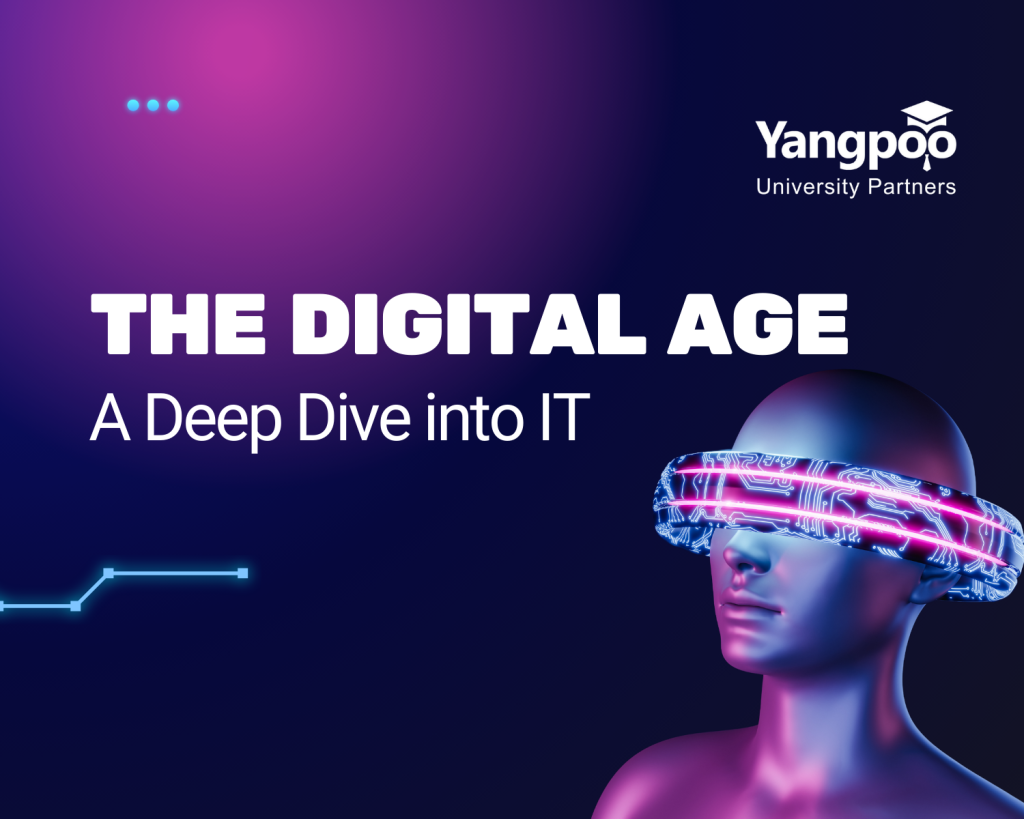Information technology (IT) involves using computers, storage, and networks to handle electronic data. It’s mainly used in business operations, unlike tech for personal or entertainment purposes. It includes both computer and communication technologies.
The term “information technology” was first used by Harvard Business Review in 1958 to differentiate between machines designed for specific tasks and general computers that could perform many functions. Over time, computing power has increased, while costs and energy use have dropped, and this trend continues with new technologies.
Types of IT:
- Internet and Web Technologies: Tools like browsers and websites that help us use the Internet.
- Cloud Computing: Services offered over the internet that allows users to store and process data remotely, such as cloud storage and software.
- Databases: Systems for organizing and retrieving data, like MySQL and MongoDB.
- Artificial Intelligence (AI) and Machine Learning (ML): Technologies that help computers perform tasks that usually need human intelligence, such as speech and image recognition.
- Cybersecurity: Protecting systems and data from unauthorized access and attacks, using tools like firewalls and encryption.
- Internet of Things (IoT): Networks of devices and sensors that communicate with each other to automate and monitor processes.
- IT Governance: Setting rules and policies for effective IT management.
- Data Analytics and Business Intelligence (BI): Analysing large amounts of data to help businesses make decisions using tools like data mining and visualization.
What Is Information Technology (IT)?
Information Technology (IT) has become an indispensable asset for modern businesses, offering a wide range of benefits. By automating tasks, streamlining processes, and providing real-time data, IT can significantly improve efficiency and decision-making. Additionally, IT enables businesses to enhance customer experiences, drive innovation, and gain a competitive advantage in today’s digital marketplace.
History and Evolution of IT?
Information Technology (IT), in its broadest sense, is the use of computers to store, retrieve, transmit, and manipulate information. However, its specific definition has evolved, reflecting the changing landscape of technology and its applications.
Early Definitions
- Early 20th Century: The term “information technology” began to appear in the early 20th century, often referring to using machines to process information.
- 1950s: With the advent of computers, IT started to be associated more specifically with the use of electronic devices to process and store information.
Modern Definitions
- Britton Lee: In the 1980s, Britton Lee, a computer company, defined IT as “the study, design, development, implementation, application, and support of computer systems.”
- Charles P. Pfleeger: Pfleeger, a computer scientist, defined IT as “the use of computers to store, retrieve, transmit, and manipulate information.”
- Wikipedia: A more recent and widely accepted definition is provided by Wikipedia: “Information technology is the study, design, development, implementation, application, and support of computer systems hardware, software, firmware, and networking.”
Key Milestones in IT Evolution
- 1940s: The development of the first electronic computers, such as the ENIAC and UNIVAC.
- 1950s and 1960s: The emergence of mainframe computers and the development of programming languages like FORTRAN and COBOL.
- 1970s: The introduction of microprocessors, led to the development of personal computers.
- 1980s and 1990s: The rise of the internet and the widespread adoption of personal computers.
- 2000s and beyond: The growth of mobile computing, cloud computing, and big data.
The Impact of IT
It has revolutionized society in countless ways, from improving efficiency in business to enabling new forms of communication and entertainment. Its evolution has been driven by technological advancements, changing user needs, and economic factors. As technology continues to advance, IT will undoubtedly play an increasingly important role in shaping our world.
Types and Variations in Information Technology
Information Technology (IT) encompasses a wide range of specialties and fields, each with its unique focus and challenges. Here are some of the most common types of IT, along with recent advancements and emerging technologies:
Software Development
- Focus: Creating, designing, and maintaining software applications.
- Types: Web development, mobile app development, desktop software development, systems software development.
- Advancements: Low-code/no-code development platforms, cloud-native development, artificial intelligence-powered development tools.
Networking
- Focus: Designing, building, and maintaining computer networks.
- Types: Local Area Networks (LANs), Wide Area Networks (WANs), Internet Protocol (IP) networks, wireless networks.
- Advancements: 5G networks, network virtualization, Software-Defined Networking (SDN).
Cybersecurity
- Focus: Protecting computer systems and networks from cyber threats.
- Types: Network security, application security, data security, cloud security.
- Advancements: Advanced threat detection, behavior analytics, blockchain-based security.
Database Management
- Focus: Storing, organizing, protecting, and retrieving data.
- Types: Relational databases, NoSQL databases, data warehouses, data lakes.
- Advancements: Cloud-based databases, graph databases, in-memory databases.
Emerging Technologies
- Artificial Intelligence (AI): Developing intelligent systems that can learn and perform tasks autonomously.
- Machine Learning: A subset of AI that involves training algorithms on large datasets to make predictions and decisions.
- Internet of Things (IoT): Connecting everyday objects to the internet for data collection and control.
- Blockchain: A decentralized and distributed ledger technology for secure and transparent transactions.
- Cloud Computing: Storing and processing data on remote servers over the internet.
Most used Technologies and their Applications in IT
The IT landscape is constantly evolving, with new technologies emerging and existing ones becoming more sophisticated. Here are some of the most widely used technologies and their applications:
Cloud Computing
- Applications: Data storage, application hosting, infrastructure management, and disaster recovery.
- Examples: Amazon Web Services (AWS), Microsoft Azure, Google Cloud Platform (GCP)
Artificial Intelligence (AI) and Machine Learning (ML)
- Applications: Natural language processing, image and speech recognition, recommendation systems, fraud detection, and predictive analytics.
- Examples: TensorFlow, PyTorch, IBM Watson, Google AI Platform
Big Data
- Applications: Analyzing large datasets to identify patterns, trends, and insights.
- Examples: Hadoop, Spark, Apache Kafka
Internet of Things (IoT)
- Applications: Connected devices, smart homes, smart cities, industrial automation, and healthcare.
- Examples: IoT platforms, sensors, gateways
Blockchain
- Applications: Cryptocurrency, supply chain management, identity verification, and smart contracts.
- Examples: Bitcoin, Ethereum, Hyperledger
Cybersecurity
- Applications: Protecting computer systems, networks, and data from unauthorized access, use, disclosure, disruption, modification, or destruction.
- Examples: Firewalls, antivirus software, intrusion detection systems, encryption
Mobile App Development
- Applications: Creating applications for smartphones and tablets.
- Examples: iOS, Android, React Native, Flutter
Web Development
- Applications: Building websites and web applications.
- Examples: HTML, CSS, JavaScript, React, Angular, Vue.js
Database Management
- Applications: Storing, organizing, and retrieving data.
- Examples: MySQL, PostgreSQL, Oracle, MongoDB
DevOps
- Applications: Collaborating between software development and IT operations to automate and streamline software delivery.
- Examples: CI/CD pipelines, containerization (Docker, Kubernetes), configuration management tools (Ansible, Puppet)
Virtual Reality (VR) and Augmented Reality (AR)
- Applications: Gaming, education, training, and entertainment.
- Examples: VR headsets, and AR glasses.
Role of Information Technology in India
The Information Technology (IT) and Business Process Management (BPM) sectors have emerged as crucial pillars of India’s economic development. Together, they significantly contribute to the nation’s GDP and public welfare, underscoring the transformative power of technology in the country. In the fiscal year 2023 (FY23), the IT industry alone accounted for 7.5% of India’s GDP, a figure projected to grow to 10% by 2025. This trend reflects how integral IT has become to India’s economic landscape.
India is now poised for a new phase in its IT revolution, driven by innovative digital applications that are rapidly spreading across sectors. The country is seen globally as a digital powerhouse, with one of the largest Internet user bases in the world. Approximately 760 million Indians have access to the Internet, benefiting from some of the cheapest data rates globally. This widespread connectivity has opened doors to various opportunities for economic growth and citizen empowerment.
The foundation for this digital transformation has been laid by the Digital India Programme, which has enhanced digital infrastructure and provided broader access to technology. These efforts have positioned India as one of the fastest countries in terms of digital adoption. The government, in collaboration with private sector innovations and investments, has been instrumental in integrating digital solutions across sectors. New digital applications have reshaped various forms of work and activities, improving the quality of life for millions of citizens.
As the nation moves forward, the role of IT in driving economic value, promoting inclusivity, and empowering citizens continues to expand. Information technology has not only become a backbone for businesses but also a tool for enabling public welfare, reflecting its growing significance in modern India.
Significance of IT in 2024
In 2024, the Information Technology (IT) sector continues to play a pivotal role in India’s economic and technological landscape. Spearheaded by the Digital India program, which began in 2015, the country has made significant strides in leveraging technology to empower citizens, enhance governance, and boost economic growth. The collaborative efforts between the government and the private sector have transformed areas like e-governance, digital payments, healthcare, and education, making technology an integral part of daily life.
India’s IT industry, home to global giants like Infosys, TCS, and Wipro, is a major contributor to the country’s economic success. In 2023, the sector generated $245 billion in revenue and employed over 5.4 million people. It also accounted for 7.5% of India’s GDP, a number expected to grow further. The industry’s innovation and digital transformation efforts are positioning India as a global leader in technology adoption.
As the country moves closer to a projected $4 trillion economy by 2024-2025, IT remains a key driver of growth. Continued collaboration between the government and private enterprises will be essential to realizing the vision of a digitally empowered nation.
Hardware vs. Software: The Building Blocks of IT
In the world of Information Technology (IT), hardware and software are the foundational components that together power systems and infrastructures. Hardware refers to the physical elements of IT, from personal computers, servers, and routers to peripherals like printers and headphones. These components are crucial in maintaining an organization’s IT infrastructure. For instance, a small business might rely on a single PC, while large organizations have data centers housing complex technology systems. Managed IT services often allow businesses to rent hardware, avoiding the need for outright purchases.
On the other hand, software is the non-physical counterpart that operates within the hardware. From operating systems like Windows and Linux to applications for productivity and security, the software enables devices to perform their intended functions. Modern IT increasingly favors software-based solutions over hardware—examples include software-defined routers and next-generation firewalls (NGFW), which replace traditional physical appliances. The software also drives cloud storage, web-based applications, and virtual environments for building and hosting applications.
Both hardware and software are essential to creating a holistic IT ecosystem, each playing a crucial role in day-to-day operations. A well-structured combination of both can help businesses scale, improve performance, and manage costs effectively in today’s digital landscape.
Explore MBA Degrees from Top Universities at Yangpoo
| University | Program | Duration | Link to Program |
|---|---|---|---|
| DY Patil University | Online MBA | 2 years | Explore DY Patil Online MBA |
| Amity University | Online MBA | 2 years | Explore Amity University MBA |
| Manipal University | Online MBA | 2 years | Explore Manipal University MBA |
FAQ
What is Information Technology (IT)?
It involves the use of computers, storage, and networks to manage electronic data, primarily for business operations, encompassing both computer and communication technologies.
When was the term “Information Technology” first used?
The term was first introduced by the Harvard Business Review in 1958 to distinguish between specialized machines and general-purpose computers.
What are the main types of IT?
Key types include Internet and Web Technologies, Cloud Computing, Databases, Artificial Intelligence (AI), Machine Learning (ML), Cybersecurity, Internet of Things (IoT), and Data Analytics.
How has IT evolved?
It has evolved from early 20th-century machines to modern electronic computers, with significant milestones including the introduction of personal computers and the rise of the internet.
What is the impact of IT on society?
It has revolutionized efficiency in business, enhanced communication, and enabled new forms of entertainment, significantly shaping modern society.
What are some emerging technologies in IT?
Emerging technologies include AI, Machine Learning, IoT, Blockchain, and Cloud Computing, each driving innovation across various sectors.
How significant is IT in India’s economy?
The IT sector contributes about 7.5% to India’s GDP and is projected to grow further as digital applications expand across industries.





